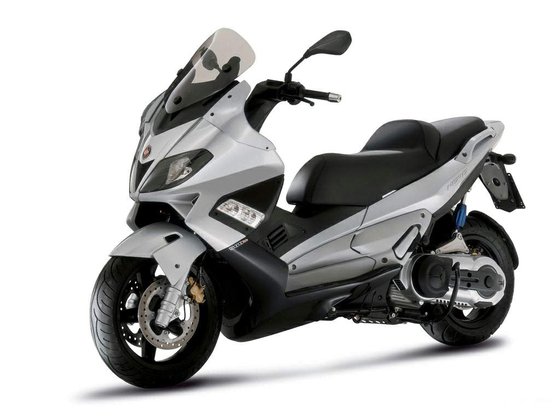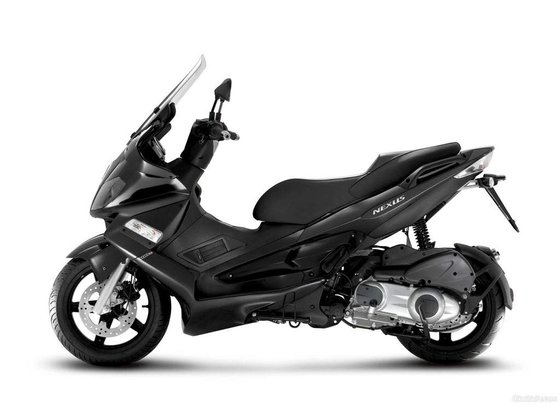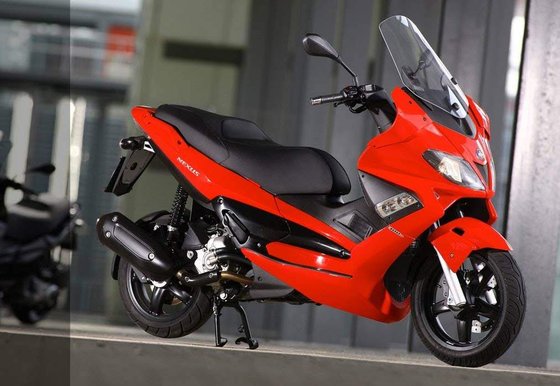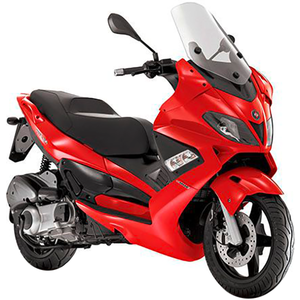Gilera Nexus 300 [2008 - 2012]: A Sporty Maxi-Scooter That Still Turns Heads

Introduction
The Gilera Nexus 300 isn’t just a scooter—it’s a statement. Produced between 2008 and 2012, this maxi-scooter blended Italian flair with practicality, carving out a niche in the competitive 300cc segment. Designed for riders who refuse to compromise between urban agility and highway confidence, the Nexus 300 remains a compelling option even today. With its Quasar engine, athletic chassis, and clever storage solutions, it’s a scooter that rewards both commuters and weekend adventurers. Let’s dive into what makes this generation stand out.
Design & Ergonomics: Italian Flair Meets Functionality

The Nexus 300’s design screams "sporty commuter." Its angular front fascia, dominated by a twin-headlight cluster, gives it a predatory stance reminiscent of Gilera’s racing heritage. The adjustable windshield (a rarity in this class) adds versatility, letting you tweak airflow for city rides or long hauls.
The seat height—815 mm (32.1 inches)—strikes a balance between accessibility and commanding road presence. The redesigned seat uses dense foam that’s firm yet supportive, ideal for hour-long rides. Three riding postures are possible: upright for traffic, slightly reclined for cruising, or shifted back for aggressive cornering. Passengers get fold-out footpegs and a sculpted rear seat, though the real star is the 34-liter underseat storage—large enough for a full-face helmet and groceries.
Color options ranged from the vibrant Rosso Dragon (Dragon Red) to understated Graphite Black. Limited editions like the Simoncelli (honoring Marco Simoncelli) and Centenario (celebrating Gilera’s 100th anniversary) added exclusive liveries, including red/white/green tricolors that channeled Italian patriotism.
Engine Performance: The Quasar Heartbeat

At the core of the Nexus 300 lies the 292cc Quasar engine—a liquid-cooled, SOHC 4-valve single-cylinder with electronic fuel injection. Producing 22.4 HP at 7,250 RPM and 23 Nm (17 lb-ft) of torque at 6,000 RPM, this mill prioritizes mid-range punch over top-end frenzy.
Twist the throttle, and the CVT transmission delivers seamless acceleration. Unlike smaller scooters that scream at high RPMs, the Nexus 300 feels composed, pulling strongly from 40 km/h (25 mph) up to its top speed of ~130 km/h (81 mph). The engine’s Euro 3-compliant exhaust emits a subdued growl, avoiding the tinny whine common in its peers.
Fuel efficiency sits around 30-35 km/l (70-82 MPG), translating to a 450 km (280 mi) range from its 15-liter (3.96 gal) tank. For a scooter capable of highway speeds, that’s impressive. The liquid cooling system keeps temps stable even during summer gridlock, a clear advantage over air-cooled rivals.
Handling & Ride Quality: A Scooter That Loves Corners
The Nexus 300’s chassis is its secret weapon. The double-cradle trellis frame—borrowed from the larger Nexus 500—feels rock-solid at speed. Paired with a 15-inch front wheel (unusually large for a scooter) and a 14-inch rear, it carves through bends with motorcycle-like poise.
The suspension setup includes a 35mm telescopic fork (94mm travel) up front and a preload-adjustable dual-shock rear (76mm travel). Over potholes, the rear can feel stiff, but that firmness pays dividends in stability during high-speed sweepers.
Braking is handled by a 260mm front disc and 240mm rear disc, both with two-piston calipers. Bite is progressive rather than abrupt, inspiring confidence in wet conditions. ABS wasn’t offered, but the wide 120/70-15 front and 140/60-14 rear Michelin tires provide ample grip.
Comfort & Practicality
Gilera nailed the ergonomics here. The floorboard is spacious enough to stretch your legs, and the contoured seat supports your lower back. The adjustable windshield does a decent job deflecting wind at 100 km/h (62 mph), though taller riders might crave an aftermarket taller screen.
Storage options are a highlight: - 34L underseat compartment (fits a full-face helmet + laptop bag) - Optional 33L top box (sold separately) - Glovebox with USB port (post-2010 models)
At 174 kg (383 lbs) dry, it’s no featherweight, but the low center of gravity aids maneuverability. Parking lot shuffles are effortless, and the belt-driven CVT eliminates clutch fatigue.
Competition: How Does It Stack Up?
The Nexus 300 faced stiff competition in its era. Here’s how it compares:
- Yamaha XMAX 300: More modern tech (like ABS) and better weather protection, but the Yamaha feels bulkier and less engaging to ride.
- Honda Forza 300: Honda’s reliability is unmatched, but the Forza’s softer suspension and muted styling lack the Gilera’s sporty edge.
- Kymco Xciting 300: Similar performance at a lower price, yet Kymco’s fit-and-finish and resale value lag behind Gilera’s.
- Piaggio Beverly 300: Shares the same engine but prioritizes comfort over dynamics. The Nexus feels sharper in corners.
The Gilera’s strengths? A stiffer frame, aggressive styling, and that intoxicating Quasar engine note. Weaknesses? No ABS and a smaller dealer network than Japanese rivals.
Maintenance: Keeping Your Nexus 300 in Peak Shape
Owners praise the Nexus 300’s reliability, but proactive maintenance is key:
- Oil Changes: Every 5,000 km (3,100 mi). Use 10W-40 JASO MA2 oil. The oil filter is easily accessible under the floorboard.
- CVT Belt: Replace every 25,000 km (15,500 mi). Look for slipping acceleration or erratic RPMs as warning signs.
- Coolant: Flush every 2 years or 20,000 km (12,400 mi). The Quasar engine runs hot, so stick to ethylene glycol-based coolants.
- Brakes: Pads wear faster if you ride aggressively. Upgrade to sintered pads for better bite.
- Tires: The 140/60-14 rear tire wears quicker than the front. Rotate tires if possible (though most owners replace them as sets).
Pro Tip: The stock exhaust’s catalytic converter can clog over time. Consider a Euro 4-compliant aftermarket system for better flow. MOTOPARTS.store offers stainless steel options that bolt on seamlessly.
Conclusion: A Scooter That Ages Gracefully
The Gilera Nexus 300 isn’t just a relic—it’s proof that passionate engineering transcends trends. Its combination of sporty handling, torquey engine, and everyday practicality makes it a joy to own even a decade later. While newer scooters boast more gadgets, few match the Nexus’s character. Whether you’re filtering through traffic or chasing horizons, this Italian maxi-scooter delivers grins per mile in spades.
Ready to enhance your Nexus 300? Explore MOTOPARTS.store’s curated selection of performance upgrades, storage solutions, and maintenance kits tailored for your ride.
Specifications sheet
| Engine | |
|---|---|
| Stroke: | Four-stroke |
| Fuel type: | RON 95 unleaded petrol |
| Max power: | 16 kW | 21.0 hp |
| Max torque: | 23 Nm |
| Fuel system: | Electronic fuel injection |
| Max power @: | 7250 rpm |
| Displacement: | 292 ccm |
| Max torque @: | 6000 rpm |
| Bore x stroke: | 75.0 x 63.0 mm (3.0 x 2.5 in) |
| Configuration: | Single |
| Cooling system: | Liquid |
| Compression ratio: | 11.5:1 |
| Number of cylinders: | 1 |
| Valves per cylinder: | 4 |
| Dimensions | |
|---|---|
| Wheelbase: | 1530 mm (60.2 in) |
| Dry weight: | 174 |
| Wet weight: | 186 |
| Seat height: | 815 mm (32.1 in) adjustable |
| Overall width: | 780 mm (30.7 in) |
| Overall length: | 2100 mm (82.7 in) |
| Ground clearance: | 165 mm (6.5 in) |
| Underseat storage: | 34 L (holds full-face + semi-jet helmet) |
| Fuel tank capacity: | 15.0 L (3.96 US gal) |
| Drivetrain | |
|---|---|
| Clutch: | Dry centrifugal type |
| Final drive: | belt |
| Transmission: | Automatic twist-and-go CVT |
| Maintenance | |
|---|---|
| Rear tire: | 140/60-14 |
| Engine oil: | 10W40 |
| Front tire: | 120/70-15 |
| Break fluid: | DOT 4 |
| Spark plugs: | NGK CR8EKB or NGK CR8E |
| Coolant type: | Water-based |
| Oil change interval: | Every 5000 km or 2 years (whichever comes first) |
| Valve clearance check interval: | 24,000 km (15,000 mi) |
| Additional Features | |
|---|---|
| Security: | Optional E-Power electronic alarm |
| Instrumentation: | Analog/digital dashboard with red backlighting |
| Emission standard: | Euro 3 |
| Adjustable windscreen: | Yes |
| Chassis and Suspension | |
|---|---|
| Frame: | Double cradle trellis made of high-strength steel tubes |
| Rear brakes: | Single 240 mm disc, two-piston floating caliper |
| Front brakes: | Single 260 mm disc, two-piston floating caliper |
| Rear suspension: | Double hydraulic shock absorber with four-position spring preload, 76 mm (3.0 in) travel |
| Front suspension: | Telescopic hydraulic fork, 35 mm shafts, 94 mm (3.7 in) travel |



















